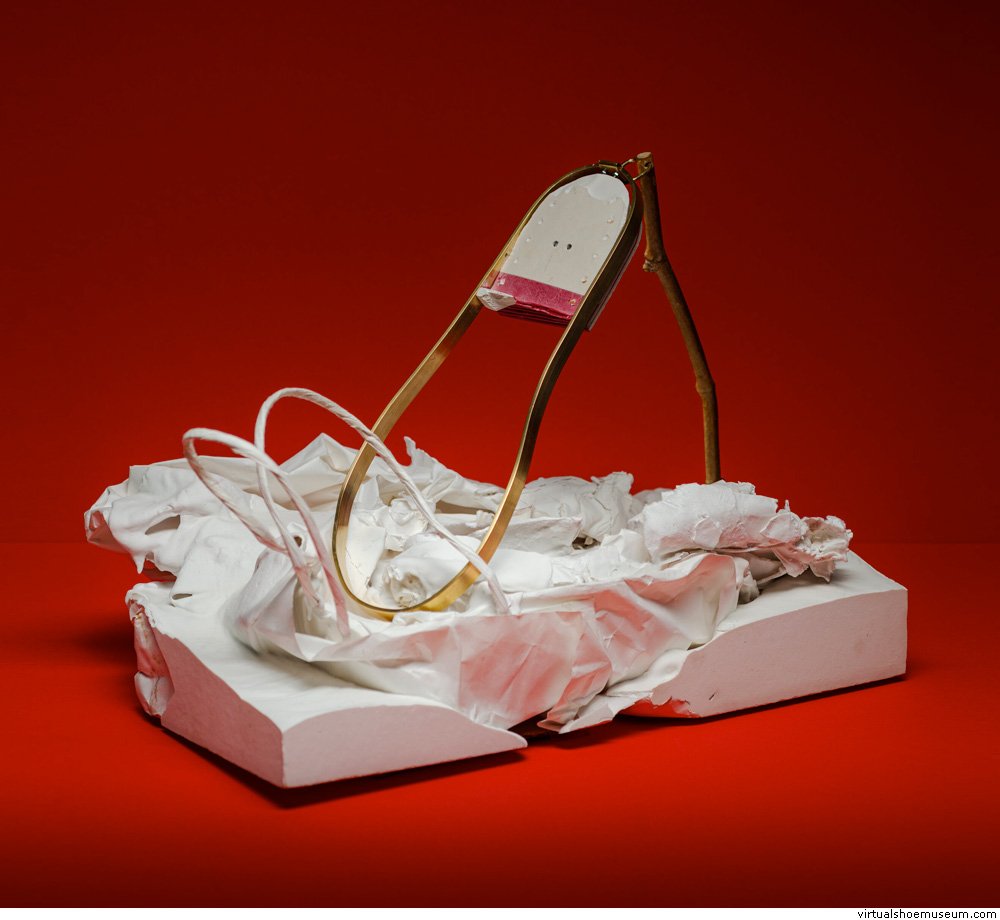Jana Zornik x Lola, 2020.
This shoe was made for the Shoes Have Names exhibition in collaboration with Jo Cope and Shelter UK which uses the power of craft to bring awareness to the individuals who face homelessness and eviction each day.
The absence of a home, a home full of absence, no space for traces.
The emptied shoe box always comes with two sponges, three pieces of paper wrapping a missing shoe, and two stuffed scraps of paper that resemble the form of the feet or a last used to fill the inside of the shoe, to keep its shape intact. The destroyed boxes, when piled up, bear a resemblance to the structure of the shoe heel. I was always fascinated with debris, its mysterious, stratified records of past lives and its endless potential of becoming something new.
While observing the waste in the shoe shop and thinking about the different meanings of a shoe, I was connecting my train of thoughts with homelessness and my case study: Lola. She had faced homelessness and moved from one temporary housing to another after a severe injury at her knee, which eventually enabled her to work. The horrendous feeling of powerlessness, while having to take on the role of the provider and encouraging parent for the children, must be soul-crushing. She was living in lots of tinny temporary settlements, that she didn’t own as a tenant, nor as an owner. No rights to build a home there… everything was temporary and on the go.
During a visit to the shoe factory in Northampton, I got to witness all the stages of becoming a shoe. While browsing around, I found lovely traces of absence in the bins of the craftsmen. They were offcuts, negative records of shoes. I knew then, that I wanted to explore this void and the symbolism behind it. The void of the shoe, of the imprint, of the possession, of the owner. There was something really poetic and very present in this absence.
The shoolessness is frequently associated with poverty. At the same time, a shoe can be a symbol of ownership. In the past, the gesture of stepping on land was used to finalised an ownership deal over a land. “To claim property, one might place shoes upon it or walk its perimeter.”My studio experimentations were firstly about the shoe waste turning into a shoe. The moment of resurrection. But after a while, it turned into a device. “The Ownership claimer” is a device that fabricates shoe traces and claims the ownership over a space. With a gentle manoeuvre of the wooden “crutch”, we can lay the heel on a surface that we want to claim, leaving a mark, an imprint. The shoebox (which it also happens to be a symbol of a tinny little place to live) and the whole purchase debris, becomes a stand for the Claimer in order to present the imprinting powers to the audience. The heel of the Claimer is also made out of the cutoffs of the pilled shoeboxes. The material vocabulary is pretty much the materialisation of the homelessness and the street. Paper, cardboard, twigs, dust and water are all materials connected to homelessness. I added some brass as I found this was also used in the factory to finish off the cardboard patterns of the shoe parts in order to make them durable.
With my piece, I wanted to arm Lola with a device that will bring home to any place she wishes upon! No more temporary settlements, no more semi-packed boxes and bags ready to go. It is time for belonging, it is time to go home!
Photo by Dan Lowe.
